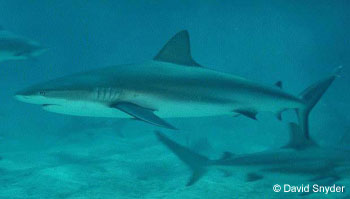
Carcharhinus perezi
This sturdy shark is abundant in the Caribbean, and because of its average features, is often confused with other requiem sharks. Usually growing 6.5 to 10 feet long, these are the apex predator of their food web. They have been found ‘sleeping’ in caves and on the ocean floor, behavior that is still unexplained. There has been concern over eating these sharks because of the build-up of toxins in their flesh, but now they are valued for tourism more than food, which brings its own safety issues.
Order – Carcharhiniformes
Family – Carcharhinidae
Genus – Carcharhinus
Species – perezi
Common Names
This shark’s common name, Caribbean reef shark, is quite suitable since the shark mainly inhabits coral reefs in the Caribbean and off South America. Other common names include cabeza dura (Spanish), Caribische rifhaai (Dutch), reef shark, requin de récif (French), shark, tiburón (Spanish), and tiburón coralino (Spanish).
Importance to Humans
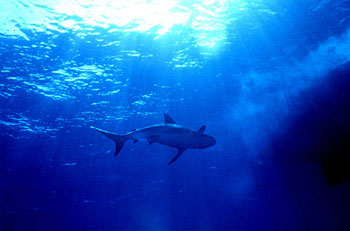
Caribbean reef sharks are prohibited from being caught by commercial fishers in U.S. waters, however harvest of these sharks may be permissible in other countries. During the past few decades, an increasingly popular (and even more controversial) commercial aspect of the Caribbean reef shark has emerged. To increase clientele, many dive-boat operations have come to include shark-feeding dives as a part of their agenda, with some of the most popular sites being main habitats of Caribbean reef sharks. Although new regulations prohibit such feedings off the coast of Florida, no such restrictions have been placed on operations in Bahamian or other Caribbean waters.
Danger to Humans
The Caribbean reef shark infrequently attacks humans. In general, a shark attack on a human is behaviorally similar to an attack upon natural prey. A human is more susceptible to being attacked if the shark is cornered and feels that there is no escape route. In situations like these, the shark may rake the victim during the attack resulting in lacerations.
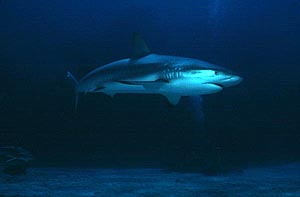
Although these characteristics have not been recorded in specific association with the Caribbean reef shark, based on observations of gray reef sharks (C. amblyrhynchos), it is possible that C. perezi may display similar behavior.
Possible signals indicating a Caribbean reef shark may attack (display threat):
- head swings well out of the normal path and may turn upward yielding a weaving or spiraling pattern in the shark’s path
- sharp, quick movements or turns increase in number
- back arches like a cat
- one or both pectoral fins are lowered with trailing edges directed to the rear
Another danger posed to humans by the Caribbean reef shark involves the accumulation of toxins in the flesh of the shark. Since sharks are apex marine predators, they may contain toxic levels of mercury and other heavy metals due to bioaccumulation (increasing concentrations at higher levels in the food web). It was found that methylmercury levels (MeHg) in sharks off the coast of Florida were higher than the FDA guidelines.
Conservation
The Caribbean reef shark is currently listed as “Near Threatened” on the World Conservation Union (IUCN) Redlist. However, these sharks are currently prohibited from capture by fishers in U.S. waters.
> Check the status of the Caribbean reef shark at the IUCN website.
The IUCN is a global union of states, governmental agencies, and non-governmental organizations in a partnership that assesses the conservation status of species.
Geographical Distribution
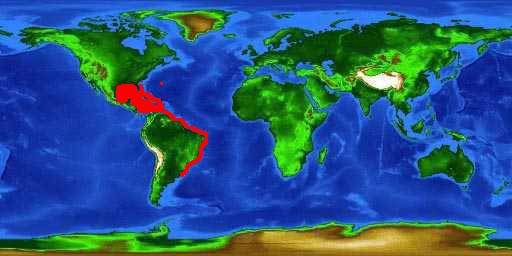
The Caribbean reef shark is found throughout tropical waters, particularly in the Caribbean Sea. This shark’s range includes Florida, Bermuda, the northern Gulf of Mexico, Yucatan, Cuba, Jamaica, Bahamas, Mexico, Puerto Rico, Colombia, Venezuela, and Brazil. It is one of the most abundant sharks around the Bahamas and the Antilles. Although Caribbean reef sharks are found near reefs in southern Florida, surveys using long-line gear off the east coast of Florida reveal that Caribbean reef sharks are extremely rare north of the Florida Keys.
Habitat
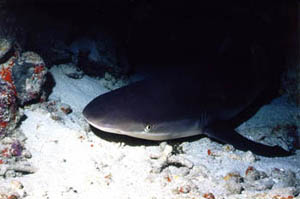
The Caribbean reef shark is the most common shark on or near coral reefs in the Caribbean. It is a tropical inshore, bottom-dwelling species of the continental and insular shelves. Although C. perezi mainly inhabits shallow waters, it has been recorded to reach depths to at least 98 feet (30 m). Caribbean reef sharks are commonly found close to drop-offs on the outer edges of coral reefs and also may lie motionless on the bottom of the ocean floor. This phenomenon has also been observed in caves off the coast of Mexico and off the Brazilian archipelago of Fernando de Noronha.
Distinguishing Characteristics
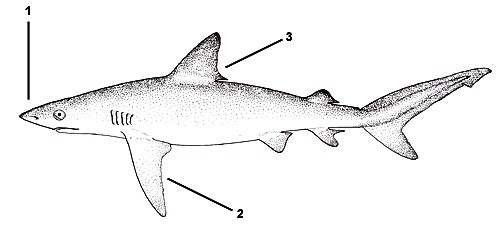
1. Snout is short and bluntly rounded
2. Pectoral fins are large and narrow
3. First dorsal fin is small with short rear tip
Biology
Distinctive Features
The Caribbean reef shark has an interdorsal ridge from the rear of the first dorsal fin to the front of the second dorsal fin. The second dorsal fin has a very short free rear tip. The snout of C. perezi is moderately short and broadly rounded. It has poorly developed, low anterior nasal flaps and relatively large circular eyes. Caribbean reef sharks also have moderately long gill slits with the third gill slit lying above the origin of the pectoral fin. Comparison to similar sharks:
- Dusky shark (C. obscurus): The dusky shark has a broadly triangular anterior upper teeth and a much longer free rear tip of the second dorsal fin.
- Sandbar shark (C. plumbeus): The sandbar shark has a snout that is shorter than the width of its mouth and a large first dorsal fin originating over the axis of the pectoral fin (the Caribbean reef shark’s first dorsal fin is further from the head than the sandbar shark). Unlike the Caribbean reef shark, the sandbar shark has widely spaced non-overlapping dermal denticles that lack defined teeth on their free edges.
- Blacktip shark (C. limbatus): The blacktip shark has a pale white anal fin, unlike the dusky colored anal fin of the Caribbean reef shark .
- Silky shark (C. falciformis): Silky sharks have a much larger free rear tip of the second dorsal fin and their teeth are more largely serrated at the bases that at the cusps.
- Bignose shark (C. altimus): This shark has a larger snout and triangular teeth that are more broad.
- Galapagos shark (C. galapagensis): Galapagos sharks have a more erect first dorsal fin, a longer free rear tip of the second dorsal fin, and more symmetrical upper teeth than Caribbean reef shark.
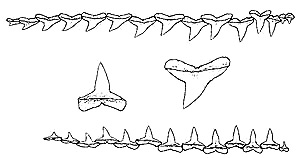
Coloration
Caribbean reef sharks are dark gray or gray-brown above, and white or whitish-yellow below. The undersides of paired fins, anal, and ventral caudal lobe are dusky colored, with no distinctive silvery gray or white undersides.
Dentition
The upper teeth of the Caribbean reef shark have narrow cusps with serrated edges and broad bases. The front two to four teeth on each side of the jaw are erect and the others are increasingly oblique. The lower teeth have narrow, erect, triangular cusps with serrated edges and broad bases.
Denticles
The dermal denticles of the Caribbean reef shark have a large number of marginal teeth and ridges. They are closely and regularly overlapping. The denticles are broader than they are long, with five (or, in larger sharks, sometimes seven) short, marginal teeth and an equal number of low ridges.
Size, Age & Growth
The maximum recorded length for C. perezi is 116 inches (295 cm). Maturity occurs at approximately 60 to 66 inches (152-168 cm) in males and 79 to 116 inches (200-295 cm) in females. The size at birth is below 29 inches (74 cm).
Food Habits
Like many sharks, the Caribbean reef shark mainly eats bony fishes. The shark uses six keen senses to locate its prey: olfactory, visual, tactile (including water vibration sensitivity through a lateralis canal system), auditory, gustatory, and electric reception. The Caribbean reef shark is especially adapted to detecting low frequency sounds (indicative of a struggling fish nearby).
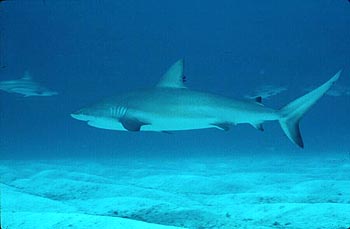
Reproduction
The Caribbean reef shark is a viviparous species, meaning its developing embryos are nourished via a placental connection. The litters average four to six pups. Although this shark’s reproduction has not been studied in the northern hemisphere, but to the south, parturition occurs during the Amazon summer of November to December. Pregnant females are often found to have biting scars from males on the sides of their bodies, due to the aggressive behaviors of males during mating. Gestation is believed to take approximately one year. A pregnant female with biting scars and wounds on the sides of her body, taken off the coast of north-northeastern Brazil, carried four near-term embryos. One was a 27.5 in. (700 mm) long male and three were females measuring 27.0 in. (685 mm), 27.4 in. (697 mm), and 27.7 in. (704 mm) in length. Because she was carrying near-term embryos, it is postulated that this area may be a pupping ground. Although such captures have shed light on the topic, relatively little is known about the reproduction of the Caribbean reef shark. Much information has been obtained from a pregnant female carrying four near-term embryos off the coast of northeastern Brazil. This female had scars and wounds on her side. Because the shark carried near-term embryos, it is postulated that this area may be a pupping ground.
Parasites
A dark leech is often attached to the dorsal fin of the Caribbean reef shark. Few parasites have been formally documented in association with C. perezi.
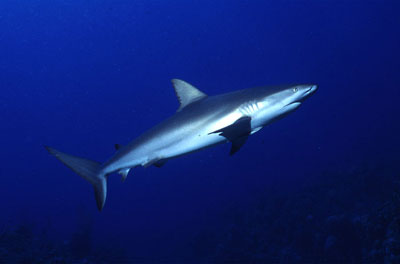
Predators
It is likely that small or juvenile Caribbean reef sharks fall prey to larger sharks such as the tiger shark and bull shark.
Taxonomy
The Caribbean reef shark was originally described from off the coast of Cuba as Platypodon perezi by Poey in 1876. Bigelow and Schroeder later described the same species as Carcharhinus springeri in 1944 and the reef shark appears in much literature under this scientific name. The genus name Carcharhinus is derived from the Greek “karcharos” = sharpen and “rhinos” = nose. The currently accepted valid name is C. perezi (Poey 1876).
Prepared by: Alissa Scharfer